Feline lower urinary tract disease (FLUTD) is a common condition in cats, and covers a wide range of disorders including urinary stones, infections, strictures, urethral plugs and idiopathic cystitis. It is a common presenting complaint, with a prevalence of approximately 2–13% in veterinary teaching hospitals (Lekcharoensuk et al, 2001a). The most common cause is feline idiopathic cystitis, resulting in approximately 55% of cases (Saevik et al, 2011). Urolithiasis is a condition where urinary stones are found in the bladder, kidney or ureters. It is seen in approximately 12–22% of cases of FLUTD (Saevik et al, 2011; Cameron et al, 2004), with the most common types of feline uroliths being struvite or calcium oxalate (Osborne et al, 2008). Urolithiasis can cause urethral obstruction, which is a serious life threatening condition, and is generally seen in young, male indoor cats with high body weight (Gerber et al, 2005). It is more common in male cats as the urethra of males is longer and narrower than females. Unfortunately, FLUTD is most often a recurrent condition, which can be frustrating for both the client and veterinarian and costly to treat. Effective, long-term management options are therefore essential.
Signs of FLUTD
There are a number of common signs associated with FLUTD which are listed in Box 1 below. Cats may only show one sign such as haematuria, or they may have a combination of different clinical signs. If cats develop a urethral obstruction then they may present collapsed as an emergency due to metabolic derangements and acute renal failure.
Box 1.Common clinical signsStranguria — painful, frequent urination of small volumesDysuria — painful urinationPollakiuria — frequent urinationPeriuria — urination in inappropriate placesHaematuria — the presence of blood in the urine
Regardless of the underlying aetiology, cats with FLUTD can present with very similar signs, and as such it is often not possible to determine the underlying cause based on clinical presentation alone. Further investigations (Box 2) usually include blood work and urinalysis in the first instance. Blood work is particularly important for cats with a urethral obstruction as they are often azotaemic and hyperkaelamic. The hyperkalaemia can cause a bradycardia and can be life threatening if untreated and as such early detection is essential. Abdominal radiographs and ultrasound are useful to determine if there are uroliths or a mass causing the clinical signs. Contrast studies including pneumocystogram and retrograde urethogram are useful for detecting stones which are radiolucent, and as such are not easily detected on plain radiographs, or urethral spasm which (being dynamic) may not be seen on a static radiograph. A rectal examination should be performed while the cat is under anaesthesia as a urethral stone or urethral disease (such as a mass or focal thickening due to urethral spasm) may be identified. Although prostatic disease is uncommon in cats, this can also cause dysuria and as such palpation of the prostate is essential in male cats.
Box 2.Full diagnostic work upHistoryPhysical examinationHematology and serum biochemistryUrinalysis — urine specific gravity, dipstick evaluation, sediment examination and urine cultureAbdominal radiographs/ultrasound/and rectal examinationPneumocystogram and retrograde urethrogram
Predisposing factors to FLUTD
Several predisposing factors for the development of FLUTD have been identified (Lekcharoensuk et al, 2001a; Gerber et al, 2005). Associations between age and some specific types of FLUTD have been detected (Lekcharoensuk et al, 2001a). For example, cats between 2–7 years of age had an increased risk of urolithiasis, urethral plugs, neurogenic disorders, and iatrogenic injuries (Lekcharoensuk et al, 2001a). Cats between 4–10 years had increased risk for urolithiasis, urethral obstructions and idiopathic feline cystitis. In addition, male, overweight and pedigree cats are at an increased risk of developing FLUTD (Lekcharoensuk et al, 2001a). Several stress factors have been associated with feline idiopathic cystitis and cats in multi cat households, particularly in which there is conflict between cats, are at increased risk (Markwel et al, 1999). Diet also appears to play a role, with cats fed dried food diets being at an increased risk (Gerber et al, 2005).
Case study 1.Floyd, a 2-year-old male neutered domestic longhaired cat presented to the Royal (Dick) School of Veterinary Studies (R(D) SVS) in April 2011 for further investigation of haematuria and dysuria. One year prior to presentation he had had an episode of cystitis which resolved with meloxicam (Metacam, Boehringer Ingelheim Limited) and cystease (glucosamine capsules, Ceva). He had been asymptomatic until 1 month prior to presentation when he developed haematuria and pollakiuria again. He was treated with dantrolene, prazosin and cystease (Cystease, Ceva) which did not resolve his signs, so he was hospitalized. Urinary catheterization was attempted, however this was unsuccessful and he was managed at the referring veterinary practice with intravenous fluids and repeated cystocentesis to decompress his bladder.On presentation to R(D)SVS he was quiet, but alert and responsive. The bladder was firm and moderate in size and the rest of the physical examination was otherwise unremarkable. Haematology and serum biochemistry revealed no significant abnormalities. Floyd was anaesthetized and a urinary catheter was successfully placed. Urinalysis revealed a large amount of blood, protein and struvite crystals, and culture was negative. Abdominal ultrasonography and contrast urethrocystogram was performed which revealed no significant abnormalities. Floyd was therefore diagnosed with feline idiopathic cystitis. An indwelling catheter was placed and medical management was instituted with prazosin, zylkene (Zlykene, MSD Animal Health) acepromazine (ACP, Novartis UK) and intravenous fluid therapy, however the urinary catheter blocked overnight and Floyd re-obstructed the following day. Floyd was therefore taken to surgery to place a cystotomy tube. Floyd recovered well from the surgery and the cystotomy tube was removed 10 days post placement. He was able to urinate normally and was discharged with prazosin and zylkene (Feliway, Ceva). Environmental management was instituted at home with the addition of feliway diffusers (Feliway, Ceva) and multiple litter trays. He was also started on a urinary diet (such as PURINA VETERINARY DIETS (R) FELINE UR ST/OX). This diet was introduced at home rather than in the hospital to avoid any possible food aversion to the diet as he will be on this diet long term. Floyd will need long-term management for his condition, and so far he has done very well — since discharge 4 months ago he has had no relapses.
Current treatment options
A multi-modal approach to therapy is often employed. Recurrence of clinical signs has been shown to be reduced in cats fed a canned diet when compared with dry food, 11% versus 39% respectively (Markwel et al, 1999). Increasing the water intake of patients is important and increasing the moisture content of food has been shown to decrease the risk of urolith recurrence (Lekcharoensuk et al, 2001a).
Dietary management is important in the control of the FLUTD. Previous studies have identified that diets with the highest moisture or protein contents and with moderate magnesium, phosphorus, or calcium contents were associated with decreased risk of calcium oxalate urolith formation; in addition diets with the highest magnesium, phosphorus, calcium, chloride, or fibre contents and moderate protein content were associated with increased risk of struvite urolith formation (Lekcharoensuk et al 2001b; Lulich et al 2004). Obese cats are predisposed to developing FLUTD (Lekcharoensuk et al, 2001a), and instituting a weight control regimen, encouraging exercise and increasing activity and playing behaviour can all assist in management of cases.
Stress has been shown to be a key factor in predisposing cats to developing feline idiopathic cystitis and in one study significantly more owners of cats with lower urinary tract signs than owners of healthy cats or cats with other diseases perceived that their cats had fear, nervousness, and aggression (Buffington et al, 2006). Therefore, treatment strategies have also focused on reducing stress in symptomatic cats. Feliway® (Feline facial pheromone fraction F3, Ceva) is a synthetic feline pheromone that is commercially available as a spray or plug-in diffuser. A previous placebo controlled pilot study evaluated the use of Feliway® in 12 cats with feline idiopathic cystitis. The cats were randomly assigned to one of two treatment groups. 6 cats were exposed to Feliway® for 2 months then a placebo for 2 months and the other 6 were exposed to placebo then Feliway®. This study did not identify any statistical differences between the two treatment groups, however there was a trend for the cats exposed to Feliway® to show fewer days with clinical signs of cystitis, a lower overall clinical score, a reduced number of episodes of cystitis and reduced negative behavioural traits (e.g. less aggression and fear) (Gunn-Moore and Cameron, 2004).
Case study 2.Gato (Photo 1) is a 6-year-old male neutered domestic shorthair that presented to the Royal (Dick) School of Veterinary Studies (R(D)SVS) in May 2011 for investigation of pollakiuria. He had no previous medical history and was otherwise in good health. On presentation he was bright and alert, and no abnormalities were detected. Blood work was unremarkable and abdominal ultrasonography and radiographs were performed which revealed a large obstructive urolith (Photo 2). Cystocentesis was performed and urinalysis revealed large amounts of blood and protein, and culture was negative. A double contrast cystourethrography was performed in order to detect any other urinary stones or abnormalities and none were seen. An exploratory laparotomy was performed and a single urolith was removed from the bladder. The urolith was sent for analysis and was consistent with calcium oxalate. Gato recovered well from surgery and was started on a urinary diet (such as PURINA VETERINARY DIETS (R) FELINE UR ST/OX) and his owners were encouraged to increase his water intake. He has been doing very well since surgery and has had no more recurrences since he was discharged 3 months ago.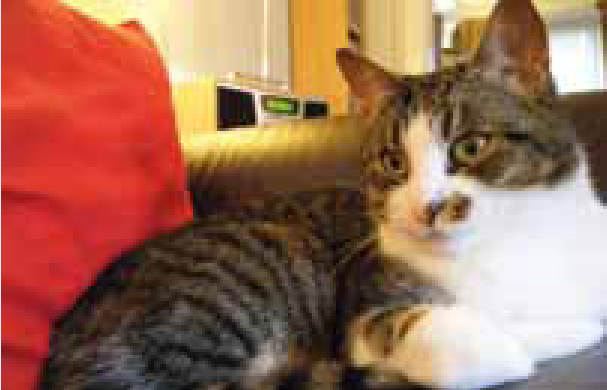
Photo 1. Gato
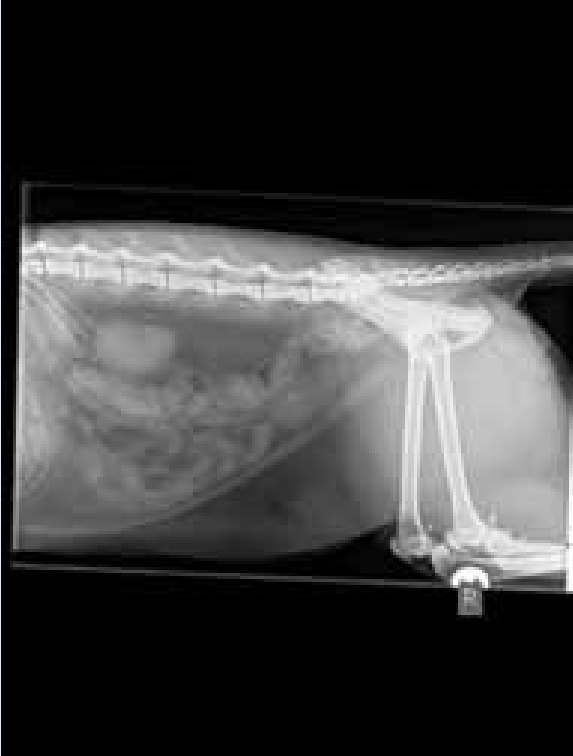
Photo 2. Radiograph illustrating large urolith in the bladder.
Dietary management with PURINA VETERINARY DIETS (R) FELINE ST/OX
Feline UR ST/OX™ (Figure 2) (PURINA, Croydon, UK) has been specially formulated to dissolve struvite stones, reduce the recurrence of both struvite and oxalate stones and help manage feline idiopathic cystitis. The diet has an increased sodium content which increases water intake and in addition it is mildly acidic — this helps dissolve and prevent reformation of struvite by decreasing the concentration of the crystals in the urine, and at a more acidic pH the stones are able to dissolve more readily as struvite is more soluble at a urine pH <6.8. Calcium oxalate stones (Figure 3) are not able to be medically dissolved, however the diet can help reduce recurrence. The increased moisture content assists in the production of less concentrated urine which decreases the concentration of crystals in the urine. Cats with feline idopathic cystitis have been shown to benefit from increased water intake and the increased sodium content in this diet can therefore help with the management of these cases.
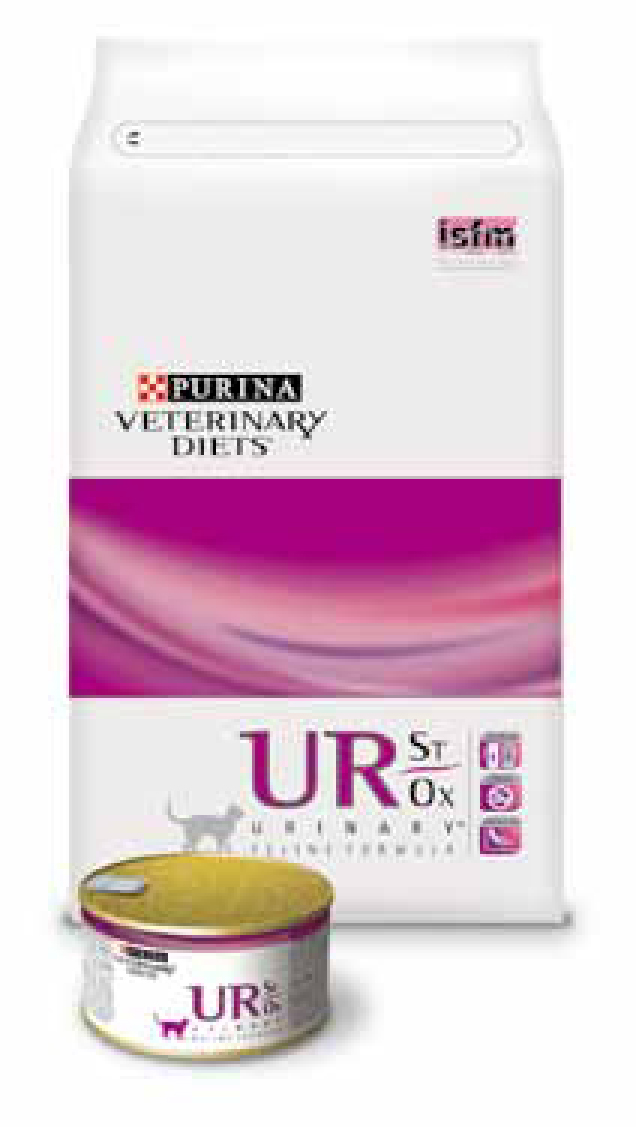
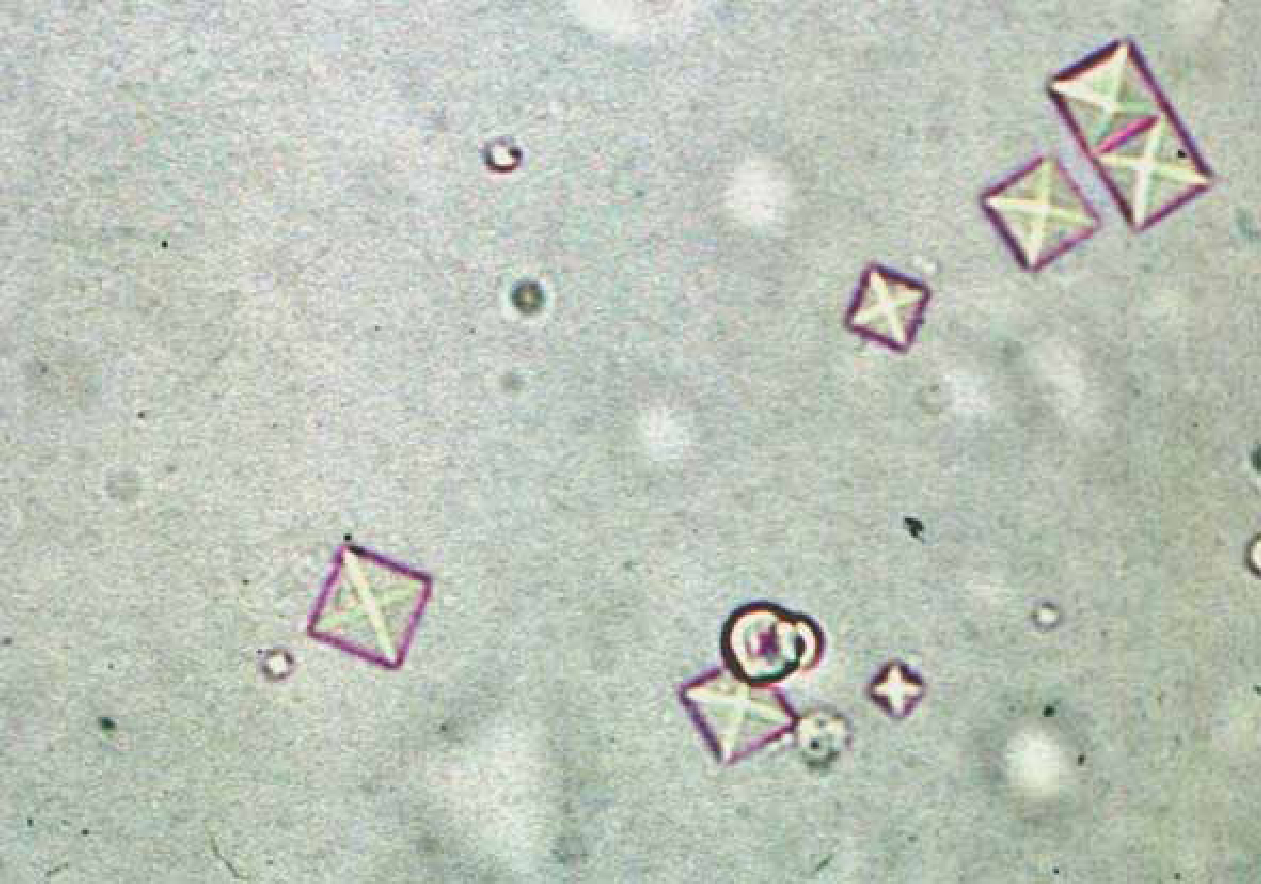
Feline UR ST/OX™ is available in both wet and dry formulations. The dry formulation contains an increased amount of sodium compared with normal diets which increases water consumption and therefore aids in the production of dilute urine. Feline UR ST/OX™ has been demonstrated to increase water intake by up to 20%, and increase urine volume by up to 40% (Figure 4 and 5) (PURINA study, 2008).
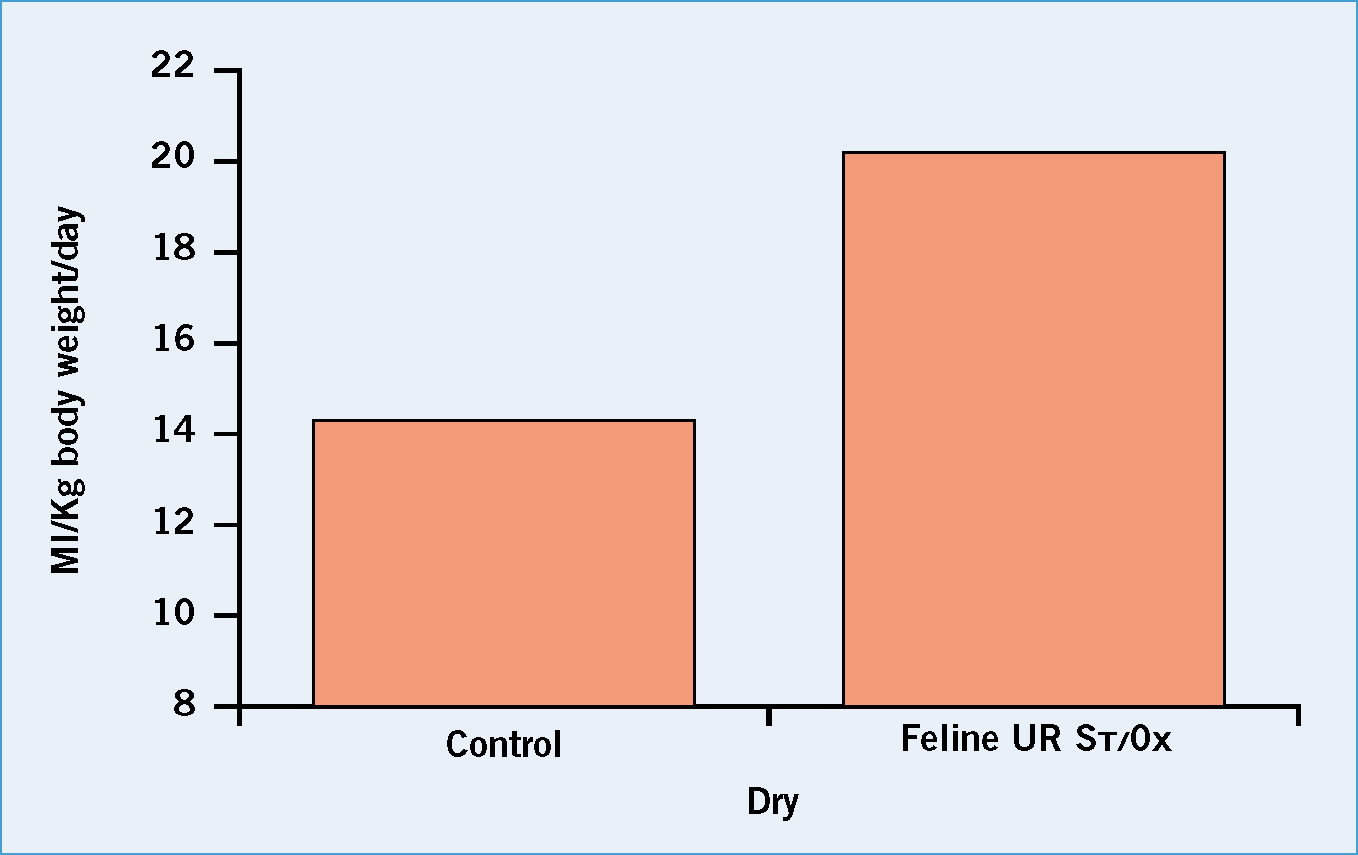
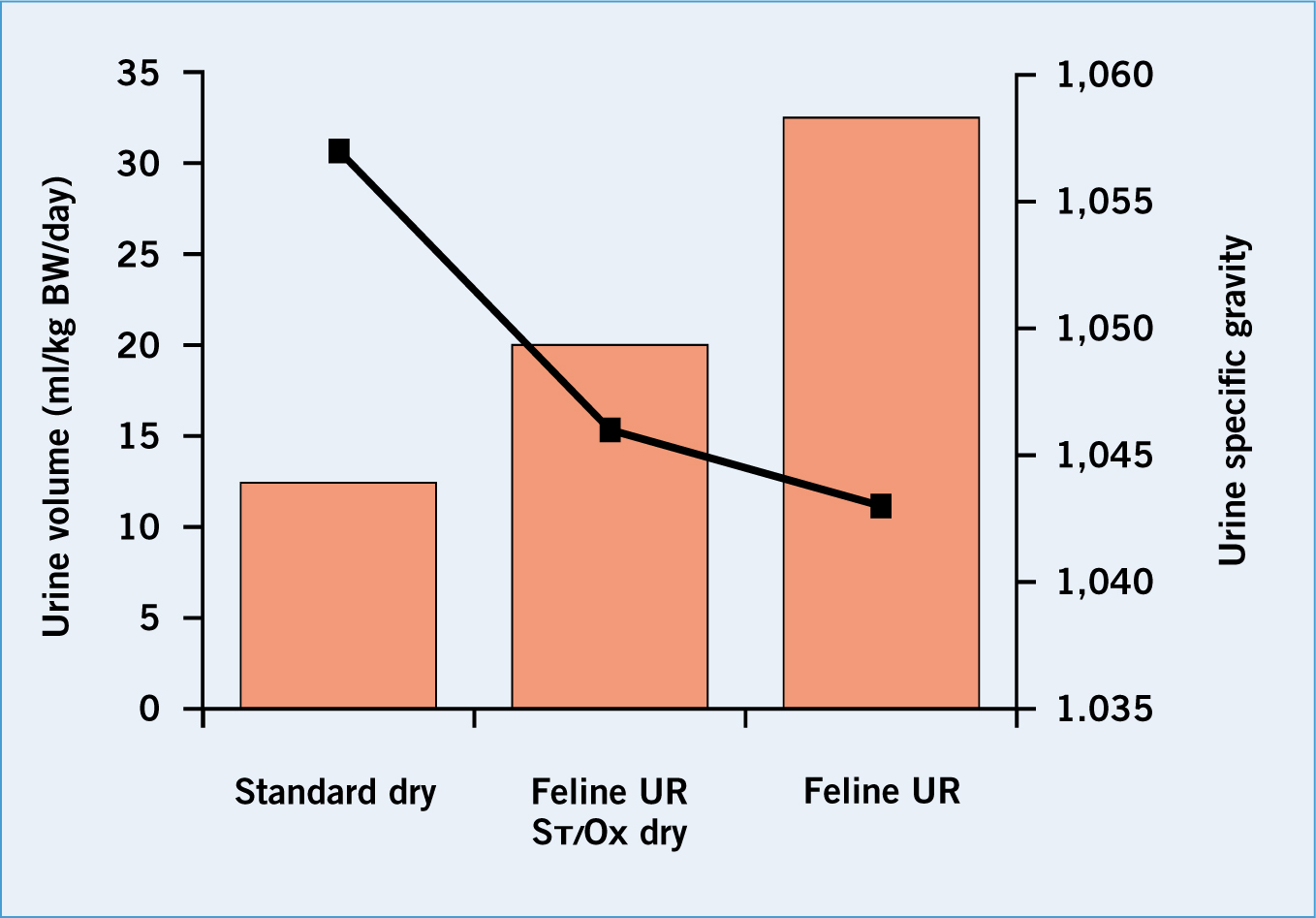
Since overweight and obese cats are predisposing factors for FLUTD, Feline UR ST/OX™ has been specifically developed with reduced fat levels and optimal protein to help achieve and maintain ideal body condition.
The Activity Product Ratio (APR)
There are two methods that are most frequently used for the assessment of the rate of urolith formation or dissolution. These are the relative supersaturation (RSS) and the activity product ratios (APR). The APR is a more sensitive index of urine saturation for stone-forming compounds than RSS. An APR of less than one represents undersaturation of urine with the mineral being evaluated and an APR greater than one indicates that the patient's urine sample is supersaturated with the mineral being evaluated and is therefore at risk of developing uroliths (Adams et al, 2010). These methods are able to determine the risk of an animal developing uroliths, and in addition, APRs can be used to investigate the efficacy of special diets on the degree of supersaturation of a patient's urine (Bartges, 2002).
In addition, the urine APR for calcium oxalate and struvite formation is decreased at a higher sodium concentration, such that urine is metastable for calcium oxalate and is undersaturated for struvite formation (Xu et al, 2006; PURINA study, 2008). Metastable means that although existing stones will not dissolve, any new crystals or growth of existing crystals or urinary stones should not occur.
The APR for Feline UR ST/OX™ has been measured and indicates that the urine of cats fed Feline UR ST/OX™ is undersaturated for struvite and thus existing struvite crystals or stones should dissolve. The APR values for calcium oxalate (CaOx) indicate that the urine of cats fed Feline UR ST/OX™ is metastable for CaOx so no new CaOx crystals should form (PURINA study, 2008; Adams et al, 2010). Currently PURINA VETERINARY DIETS (R) Feline UR ST/OX is the only diet to be shown to be effective using both APR and RSS.
Conclusion
FLUTD is a complex condition with numerous possible underlying causes. In addition, long-term treatment strategies are often required to achieve good control. Dietary management can be a simple and effective method for the two most common causes of FLUTD; feline idiopathic cystitis and urolithiasis. A urinary diet such as Feline UR ST/OX™ can assist in the treatment of these cases by dissolving struvite uroliths, reducing recurrence of both struvite and oxalate uroliths and helping manage feline idiopathic cystitis. In addition, the reduced fat level and a high level of protein is designed to minimize obesity, which is a known risk factor for urinary tract obstruction by uroliths, while still maintaining optimum body condition and nutrition.
Key Points
- The two most common causes of feline lower urinary tract disease (FLUTD) are feline idiopathic cystitis and urolithiasis.
- FLUTD is often a recurring condition requiring effective long-term management.
- Environmental modification by increasing water intake, reducing stress and increasing the number of litter trays has been shown to be important.
- Dietary management can play a key role in preventing and reducing recurrence of episodes.
- Feline UR ST/OX™ is designed to assist in the management of feline idiopathic cystitis and struvite and calcium oxalate urolithiasis.
